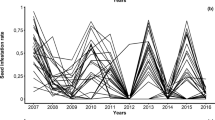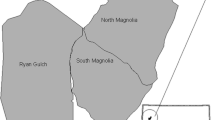Abstract
Understanding the ways that resource heterogeneity shapes the performance of individuals and the dynamics of populations offers a central challenge in contemporary ecology. Emerging evidence shows that herbivores track heterogeneity in nutritional quality of vegetation by responding to phenological differences in plants, differences that result from spatial and temporal variation in conditions favoring plant growth. Theory predicts that when spatial variation in temperature, nutrients, or moisture results in spatially asynchronous pulses of plant growth, herbivores are able to prolong the period during which they have access to forage of peak nutritional value. Although this idea has substantial support from observational and modeling studies, it has not been examined experimentally. We hypothesized that access to asynchronous resources enhances nutritional status and growth of herbivores and that the magnitude of this effect depends on the scale of access relative to the grain of resources. We tested these hypotheses in mesocosm experiment using the migratory grasshopper, Melanoplus sanguinipes, feeding on young wheat and protein-rich bran as a model system. We demonstrated access to asynchronous pulses in resources enhanced the efficiency of use of high quality resource use and increased growth of individuals by 13%. Disruption of this mechanism when landscapes were fragmented lowered efficiency of resource use and caused growth of individuals to decline by 15%. However, the strength of the effects of fragmentation on herbivore performance depended on the spatial extent of fragmentation relative to the spatial and temporal grain of resource emergence. Our findings add experimental support to modeling and observational studies that have linked herbivore performance to spatial and temporal variation in plant phenology. We also offer evidence that fragmentation can impair herbivore performance, even when the total amount and quality of resources on landscapes remains unchanged.



Similar content being viewed by others
References
Albon SD, Langvatn R (1992) Plant phenology and the benefits of migration in a temperate ungulate. Oikos 65:502–513
Bancroft JS, Turchin P (2003) An experimental test of fragmentation and loss of habitat with Oryzaephilus surinamensis. Ecology 84:1756–1767
Boone RB (2007) Effects of fragmentation on cattle in African savannas under variable precipitation. Landsc Ecol 22:1355–1369
Boone RB, Hobbs NT (2004) Lines around fragments: effects of fencing on large herbivores. Afr J Range Forage Sci 21:147–158
Boone RB, BurnSilver SB, Thornton PK, Worden JS, Galvin KA (2005) Quantifying declines in livestock due to land subdivision. Range Ecol Manag 58:523–532
Boone RB, Thirgood SJ, Hopcraft JGC (2006) Serengeti wildebeest migratory patterns modeled from rainfall and new vegetation growth. Ecology 87:1987–1994
Caley MJ, Buckley KA, Jones GP (2001) Separating ecological effects of habitat fragmentation, degradation, and loss on coral communities. Ecology 82:3435–3448
Cebrian J, Lartigue J (2004) Patterns of herbivory and decomposition in aquatic and terrestrial ecosystems. Ecol Monogr 74:237–259
Davis RM, Skold MD (1996) Regional economic thresholds in grasshopper management. In: Cunningham GL, Sampson ML (eds) Grasshopper integrated pest management user handbook. Technical Bulletin no. 1809. USDA/APHIS, Washington DC, USA, pp VI4.1–VI4.4
Doncaster CP (2001) Healthy wrinkles for population dynamics: unevenly spread resources can support more users. J Anim Ecol 70:91–100
Dunning JB, Danielson BJ, Pulliam HR (1992) Ecological processes that affect populations in complex landscapes. Oikos 65:169–175
Durant JM et al (2005) Timing and abundance as key mechanisms affecting trophic interactions in variable environments. Ecol Lett 8:952–958
Fielding DJ, Defoliart LS (2008) Discriminating tastes: self-selection of macronutrients in two populations of grasshoppers. Physiol Entomol 33:264–273
Frank DA, McNaughton SJ (1992) The ecology of plants, large mammalian herbivores, and drought in Yellowstone National Park. Ecology 73:2043–2058
Fryxell JM (1991) Forage quality and aggregation by large herbivores. Am Nat 138:478–498
Fryxell JM, Sinclair ARE (1988) Causes and consequences of migration by large herbivores. Trends Ecol Evol 3:237–241
Fryxell JM, Wilmshurst JF, Sinclair ARE (2004) Predictive models of movement by Serengeti grazers. Ecology 85:2429–2435
Fryxell JM, Wilmshurst JF, Sinclair ARE, Haydon DT, Holt RD, Abrams PA (2005) Landscape scale, heterogeneity, and the viability of Serengeti grazers. Ecol Lett 8:328–335
Haley SD, Quick JS, Johnson JJ, Peairs FB, Stromberger JA, Clayshulte SR, Clifford BL, Rudolph JB, Seabourn B, Chung OK, Jin Y, Kolmer J (2005) Registration of ‘Hatcher’ wheat. Crop Sci 45:2654–2656
Hebblewhite M, Merrill E, McDermid G (2008) A multi-scale test of the forage maturation hypothesis in a partially migratory ungulate population. Ecol Monogr 78:141–166
Hewitt GB, Onsager JA (1982) A method for forecasting potential losses from grasshopper feeding on northern mixed prairie forages. J Range Manag 35:53–57
Hobbs NT, Gordon IJ (2010) How does landscape heterogeneity shape population dynamics? In Owen Smith N (eds) Dynamics of large herbivore populations in changing environments: toward appropriate models. Wiley-Blackwell, NJ (in press)
Hobbs NT, Galvin KA, Stokes CJ, Lackett JM, Ash AJ, Boone RB, Reid RS, Thornton PK (2008) Fragmentation of rangelands: implications for humans, animals, and landscapes. Glob Environ Change 18:776–785
Holand O, Weladji RB, Roed K, Gjostein H, Kumpula J, Gaillard JM, Smith ME, Nieminen M (2006) Male age structure influences females’ mass change during rut in a polygynous ungulate: the reindeer (Rangifer tarandus). Behav Ecol Sociobiol 59:682–688
Holdo RM, Holt RD, Fryxell JM (2009) Opposing rainfall and plant nutritional gradients best explain the wildebeest migration in the Serengeti. Am Nat 173:431–445
Illius AW, O’Connor TG (2000) Resource heterogeneity and ungulate population dynamics. Oikos 89:283–294
Ims RA (1990) On the adaptive value of reproductive synchrony as a predator-swamping strategy. Am Nat 136:485–498
Mattson WJ (1980) Herbivory in relation to plant nitrogen-content. Annu Rev Ecol Syst 11:119–161
McNaughton SJ (1979) Grazing as an optimization process—grass ungulate relationships in the Serengeti. Am Nat 113:691–703
McNaughton SJ (1984) Grazing lawns—animals in herds, plant form, and coevolution. Am Nat 124:863–886
McNaughton SJ (1985) Ecology of a grazing ecosystem—the Serengeti. Ecol Monogr 55:259–294
McNaughton SJ (1986) Grazing lawns—on domesticated and wild grazers. Am Nat 128:937–939
McNaughton SJ (1990) Mineral-nutrition and seasonal movements of African migratory ungulates. Nature 345:613–615
McNaughton SJ, Oesterheld M, Frank DA, Williams KJ (1989) Ecosystem-level patterns of primary productivity and herbivory in terrestrial habitats. Nature 341:142–144
Mueller T, Olson KA, Fuller TK, Schaller GB, Murray MG, Leimgruber P (2008) In search of forage: predicting dynamic habitats of Mongolian gazelles using satellite-based estimates of vegetation productivity. J Appl Ecol 45:649–658
Mysterud A, Langvatn R, Yoccoz NG, Stenseth NC (2001) Plant phenology, migration and geographical variation in body weight of a large herbivore: the effect of a variable topography. J Anim Ecol 70:915–923
Owen-Smith N (2004) Functional heterogeneity in resources within landscapes and herbivore population dynamics. Landsc Ecol 19:761–771
Pettorelli N, Mysterud A, Yoccoz NG, Langvatn R, Stenseth NC (2005a) Importance of climatological downscaling and plant phenology for red deer in heterogeneous landscapes. Proc R Soc Lond B 272:2357–2364
Pettorelli N, Weladji RB, Holand O, Mysterud A, Breie H, Stenseth NC (2005b) The relative role of winter and spring conditions: linking climate and landscape-scale plant phenology to alpine reindeer body mass. Biol Lett 1:24–26
Pettorelli N, Pelletier F, von Hardenberg A, Festa-Bianchet M, Cote SD (2007) Early onset of vegetation growth vs. rapid green-up: Impacts on juvenile mountain ungulates. Ecology 88:381–390
Post E, Forchhammer MC (2008) Climate change reduces reproductive success of an Arctic herbivore through trophic mismatch. Philos Trans R Soc Lond B 363:2369–2375
Post E, Stenseth NC (1999) Climatic variability, plant phenology, and northern ungulates. Ecology 80:1322–1339
Rosenberg KV, Lowe JD, Dhondt AA (1999) Effects of forest fragmentation on breeding tanagers: a continental perspective. Conserv Biol 13:568–583
Tilman D (1982) Resource competition and community structure. Princeton University Press, Princeton
van Nouhuys S (2005) Effects of habitat fragmentation at different trophic levels in insect communities. Ann Zool Fenn 42:433–447
Van Soest PJ (1994) Nutritional ecology of the ruminant, 2nd edn. Cornell University Press, Ithaca
Wang GM et al (2006) Spatial and temporal variability modify density dependence in populations of large herbivores. Ecology 87:95–102
Wang GM et al (2009) Density dependence in northern ungulates: interactions with predation and resources. Popul Ecol 51:123–132
Wilmshurst JF, Fryxell JM, Hudson RJ (1995) Forage quality and patch choice by wapiti (Cervus elaphus). Behav Ecol 6:209–217
Wilmshurst JF, Fryxell JM, Farm BP, Sinclair ARE, Henschel CP (1999) Spatial distribution of Serengeti wildebeest in relation to resources. Can J Zool 77:1223–1232
Wilmshurst JF, Fryxell JM, Bergman CM (2000) The allometry of patch selection in ruminants. Proc R Soc Lond B 267:345–349
Acknowledgments
This work was supported by award DEB0444711 (Effects of Habitat Fragmentation on Consumer-Resource Dynamics in Environments Varying in Space and Time) from the United States National Science Foundation to Colorado State University. We thank S. Berg, S.C. Merrill, J. Matsuura, L. Mouttet, H. Blackburn, M. Haddix, and A. Norton for their valuable assistance with experimental work. The work reported here was supported in part by the National Science Foundation while Hobbs was serving as a rotating Program Director in the Division of Environmental Biology. Any opinions, findings, conclusions, or recommendations are those of the authors and do not necessarily reflect the views of the National Science Foundation.
Author information
Authors and Affiliations
Corresponding author
Additional information
Communicated by Roland Brandl.
An erratum to this article can be found at http://dx.doi.org/10.1007/s00442-010-1716-z
Rights and permissions
About this article
Cite this article
Searle, K.R., Hobbs, N.T. & Jaronski, S.R. Asynchrony, fragmentation, and scale determine benefits of landscape heterogeneity to mobile herbivores. Oecologia 163, 815–824 (2010). https://doi.org/10.1007/s00442-010-1610-8
Received:
Accepted:
Published:
Issue Date:
DOI: https://doi.org/10.1007/s00442-010-1610-8




